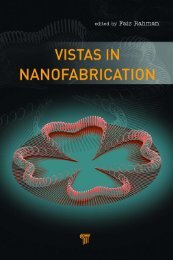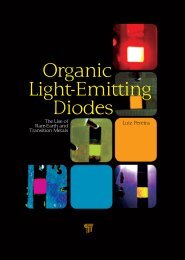Download PDF - Pan Stanford Publishing
Download PDF - Pan Stanford Publishing
Download PDF - Pan Stanford Publishing
Create successful ePaper yourself
Turn your PDF publications into a flip-book with our unique Google optimized e-Paper software.
“At a time when we are concerned about the potential hazards of engineered nanomaterials,<br />
this book gives a timely and delightful overview of the variety of nanoparticles that exist in<br />
our environment — from noble metal nanoparticles in ore systems and nanodust in the solar<br />
system to magnetic nanoparticles in homing pigeons and photonic crystals in beetles. It is<br />
an enjoyable and a useful companion for anyone interested in knowing about the potential<br />
hazards of nanomaterials and those seeking inspiration from nature to create functional<br />
materials.”<br />
Dr Ai Lin Chun<br />
Senior Editor, Nature Nanotechnology<br />
While humanity strives to synthesize and utilize functional nanomaterials, nature’s own<br />
laboratory has perfected the production of a range of highly selective nanomaterials.<br />
Natural nanomaterials (and even natural nanotechnologies) are all around us, and this<br />
ubiquity inevitably raises questions such as What are these natural nanomaterials made<br />
of Where can we find them What can they do Answering these questions will lead to<br />
a better understanding of the world around us and facilitate new and environmentally<br />
friendly ways of creating and manipulating nanoscale materials for the next generation of<br />
new technologies.<br />
This book represents the first collection of its type and is truly multidisciplinary. The<br />
compilation brings together studies from astronomy, physics, chemistry, materials<br />
science, engineering, geology and geophysics, environmental science, agricultural science,<br />
entomology, molecular biology, and health and is therefore an invaluable resource for<br />
learning how various scientists approach similar problems.<br />
Amanda S. Barnard is leader of the Virtual Nanoscience Laboratory at the<br />
Commonwealth Scientific and Industrial Research Organisation (CSIRO),<br />
Australia’s national science agency. She has a BSc and PhD in physics from<br />
RMIT University, Australia, and has held research positions at Argonne National<br />
Laboratory, USA, and the University of Oxford, UK. Using thermodynamic<br />
theory and first-principles computer simulations, she is a pioneer in the<br />
mapping of nanomorphology and the environmental stability of nanomaterials<br />
(thermodynamic cartography) and in the development of structure/property<br />
relationships for predicting the reliability of nanoparticles in high-performance<br />
applications.<br />
Haibo Guo is a postdoctoral fellow and an early-career researcher at Virtual<br />
Nanoscience Laboratory, led by Dr Amanda Barnard. He received his BS in 2001<br />
and PhD in 2006 from Tsinghua University, Beijing, China. His research interests<br />
include modeling and simulation of surfaces and interfaces in environmental<br />
and energy sciences.<br />
V288<br />
ISBN-13 978-981-4316-82-8<br />
,!7IJ8B4-dbgici!
















